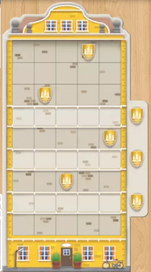|
29th May 2022 It's a Sunday Evening and we're on Board Game Arena for some gaming entertainment. Copenhagen; largest city in and capital of Denmark. Few know though, of the cities secret history of builders having ties with errr.... tetromino shapes? At least that's what the game Copenhagen would have you believe... sort of! Caveat: we've only ever played Copenhagen digitally. What's in a game?
The components for Copenhagen are pretty colourful and bright, although there's barely any art to speak of. There's also barely any iconography to speak of. The symbols on the ability tiles aren't immediately obvious and will probably require looking up in the rules a couple of times. Other than that though, everything else is easily understood. How's it play? Setup
On to play In Copenhagen, players take turns either gathering cards or playing them to gain tiles which they put on to their player board to score points. During their turn, the active player may perform exactly 1 of 2 possible actions.
Endgame Either one of two ways can trigger the game end. If the End Game card is drawn (Can only occur after shuffling the discard pile back into a draw deck.) then the game immediately ends. If a player scores a 12th point then the game immediately ends. In either case, points are tallied, highest score wins. Overall
Mechanically, Copenhagen is a fairly light, accessible game; players are either drafting cards or drafting tiles. It's the relationship between those 2 actions that's interesting. Firstly, there's not many tiles that go into the game, e.g., only 1 5-space tile is available in each colour and only 3 each of the other sizes in each colour, which is all quite deliberate. It takes more cards and thus more actions (And longer.) to get the bigger tiles which are the better tiles but there's the risk a player won't get the one they want. The bigger tiles are better because of the windows (Or lack of.) on them. Getting a lot of 2-space tiles will mean 50% of filled spaces on a player's board will be windowless, while getting a lot of 5-space tiles means only 20% of spaces are windowless. Completing a row or column with all windows essentially doubles the points that line is worth and the more windows a player can get on their board, the more likely they are to do this. This brings me to the next point, other than the 1-space tiles, every tile has a windowless space. This means it's very hard to create lines that all score windows. Players will want to position windowless spaces to minimise their effect and provides players with meaningful decisions to make. These two factors means that players are faced with a dilemma. Go for the quicker easier to get tiles and probably get a smaller score, or take the risk of losing our by going for bigger, better scoring tiles. There's definitely a higher level of play that involves watching what cards other players are drafting and trying to anticipate what colours they're going for. This kind of knowledge allows players to adapt to what they think their opponent is doing. I think Copenhagen is a fairly easy to learn game that has a streak of depth to it. Most people will pick it up fairly quickly. Having said that I personally found the game a little dull. There's nothing here that I haven't seen elsewhere, it's just packaged differently here. Copenhagen also played just a little too quickly for my liking (Normally something I'd never criticise a game for!); playing with just 3 people meant that frequently 6 cards were being drawn from the 70 card deck every round, this means the game would reach the end of the deck twice after 20-something cards drafts for each player. It felt like the game is mostly likely to deplete it's deck before a player gets to 12 points. To put that into perspective; if a player has 20-something card drafting actions, that in turn gives them the ability to draft around 50 spaces worth of tiles. The quickest way to reach 12 points is to have 6 filled rows, all with windows. That would require filling in 30 spaces at a minimum, this is provided they got the cards and tiles they wanted. I'm sure there are players out there that would find the challenge of getting to 12 points compelling but for me. It meant that I found the game unsatisfying and combined with it's blandness made it average and unremarkable. I can't really fault the game, it's just a little dull.
0 Comments
Leave a Reply. |
AuthorI play, I paint. Archives
March 2024
Categories
All
|



 RSS Feed
RSS Feed
